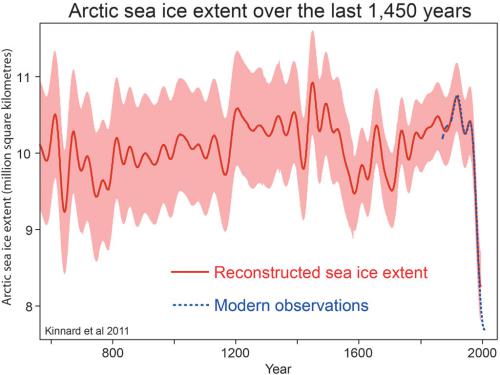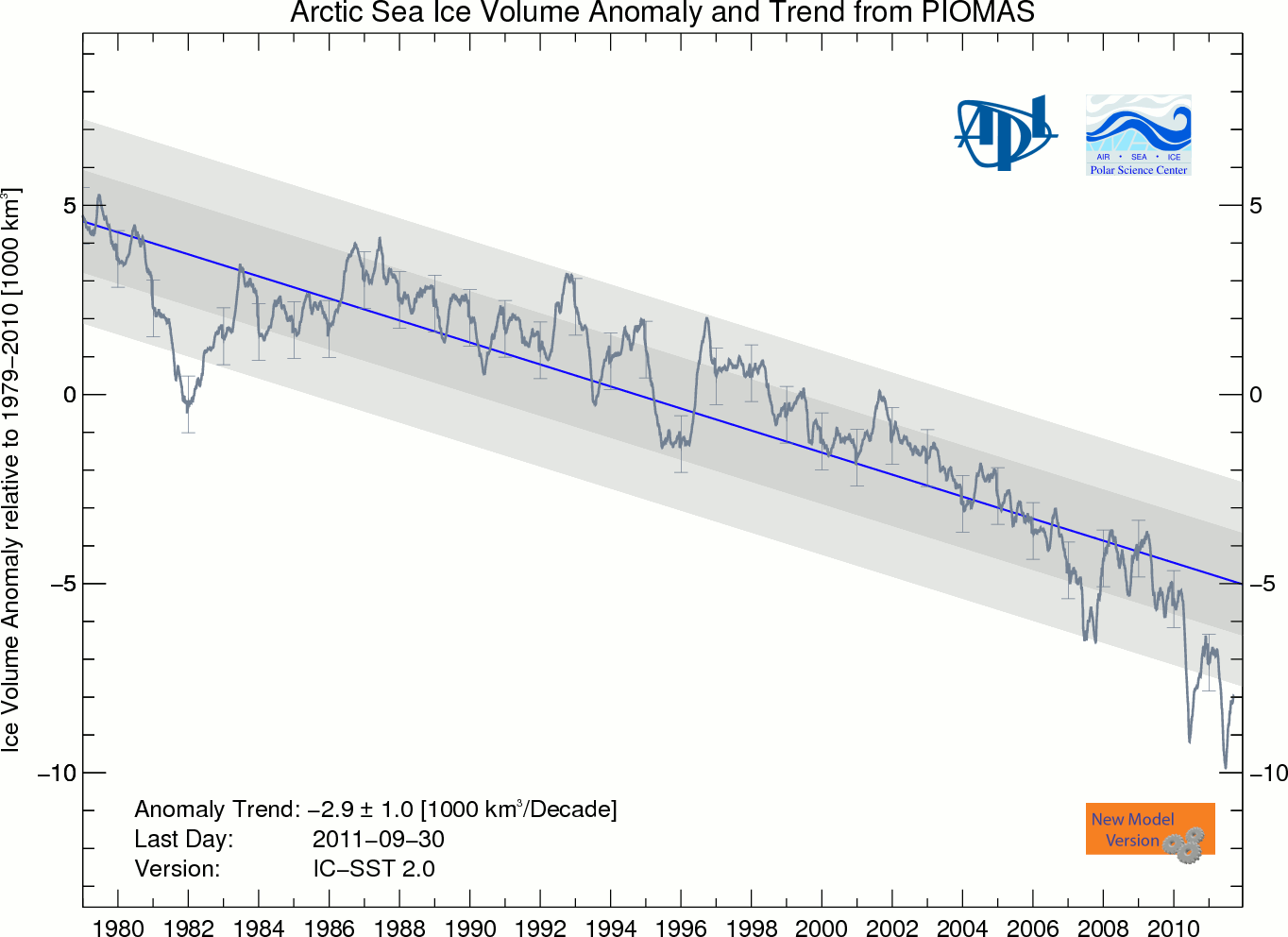Arctic Sea Ice Hockey Stick: Melt Unprecedented in Last 1,450 years
Posted on 24 November 2011 by Rob Painting
Many climate change "skeptics" obsess over the 'hockey stick', and their discussion inevitably leads back to 1998, when climate scientist Michael Mann first published his paper indicating that current global warming was anomalous in the last 1000 years or so. In plain language, Mann's work suggested that current warming was likely due to mankind's carbon dioxide pollution, not any as-yet-unidentified, or yet-to-be-discovered or observed natural phenomenon.
Despite the "skeptics" cherry-picked focus on a peer-reviewed paper more than a decade old, the science has moved on considerably since then. Paper after paper has basically affirmed that current warming is outside the bounds of natural variation, and therefore likely due to human activities. For example we have seen a sea level hockey stick, an underwater hockey stick, a South American hockey stick, an Arctic summer temperature hockey stick, a tropical glacier hockey stick, a North American mountain snowpack hockey stick, a glacier length hockey stick, and warming of Atlantic water into the Arctic hockey stick.
Into this league of hockey sticks, we have a just published scientific paper, (Kinnard [2011]), which shows that the Arctic sea ice retreat is also a hockey stick, and that the present rate of melt in the Arctic summer is unprecedented in the last 1,450 years. See figure 1. (Note that the hockey stick blade is facing down in this reconstruction).

Building a hockey stick
Because Arctic sea ice is influenced by both air and water temperatures, the study authors use a combination of Arctic ice core, tree-ring and lake sediments to reconstruct Arctic conditions over the last 2,000 years. As is often the case with these proxy reconstructions, the authors found the error bars in the reconstruction (the uncertainty) increased further back in time, due to a decreasing number of proxy records, and was not useful past 1,450 years ago.
When compared (validated) against historical sea ice observations it was found that the reconstruction not only had a dominant temperature-related signal, but that the proxy-based reconstruction also had a second signal which corresponded with variations in sea ice cover (extent), therefore confirming the 2nd network signal was a proxy for Arctic sea ice cover (as shown in figure 1).
Clearly there are periods in the reconstruction where rapid rates of ice loss occurred, but what stands out is that the length and rate of present day melt is unprecedented in the entire 1,450 year-long reconstruction. This is consistent with the Arctic summer temperature hockey stick (Kaufman [2009]) and warming of Atlantic water into the Arctic hockey stick (Spielhagen [2011]).
Arctic summer sea ice: going, going............
2011 saw the 2nd lowest summer sea ice extent on record (after 2007), and even more dramatically, this year saw the lowest ever recorded volume of Arctic summer sea ice.

This latest 'hockey stick' not only reinforces that current conditions in the Arctic are much warmer than the so-called Medieval Warm Period, but that sea ice is currently disappearing at a sustained speed that is unmatched in the last 1,450 years.































 Arguments
Arguments






























[DB] The prudent reader will note that in this discussion of Arctic Sea Ice (being by definition at sea level) Arkadiusz introduces a common "skeptic trick"/technique of introducing data from a local ice core in Greenland to "muddy the waters". The issue, beyond the core data representing but a single geospacial location and thus by itself not representative of the whole (and much larger) region in which it resides, is that the core is near the Greenland summit (in order to get the deepest profile of the ice possible) and therefore at an elevation of over 2 miles above sea level.
Permissum lector caveo (let the reader beware)...
[DB] An open copy may be found here:
http://www.leif.org/EOS/2011GL049444.pdf
Section 5.3 is relevant to this discussion.
[DB] "am I the only one who recalls the 1500-year warming-cycle?"
Apparently you're one who doesn't remember the debunking of that particular meme, here:
It's a 1500 year cycle
The prudent reader will take note of the source of "Truth"AtLast's linked blog piece, the National Center for Policy analysis, a Washington, DC-based "think tank", has produced such memorable pieces as:
How the Rise of Trendy Environmentalism is Harming the Environment
A Rough Week for Climate Change Myths
U.S. Press AWOL on Climate Skepticism
Climate Models Fail, AGAIN!
The spin is palpable; the "truth", lacking.
contextconcept, in the 1960s".[DB] "The silly story about Erik the Red came from Hubert Lamb"
Then you will certainly have no problem furnishing a link to support your Hubert Lamb claim. If he did indeed use it, then you will have to furnish also the context in which he used it and then demonstrate why that is relevant to this thread. Else you are being silly and off-topic and therefore this comment will be deleted.
"That Lamb used it shows the primitive state of temperature reconstructions just a generation ago."
This is certainly an unsupported, subjective and indeed off-topic comment. Other comments exist here on models and their qualitative states. The Search function will reveal many. Continue this line of reasoning there, not here where it is off-topic.
[DB] And with this you are back to your long-established practice of cherry-picking quotes, as Tom notes below in comment 49. The practice for which you have been cautioned and warned against ad nauseum. And which you have ackowleged with the intent to do better. Yet here we are.
Language barriers are no longer an excuse, as this behavior is demonstrably willful. No more.
[DB] Tom again deconstructs your continued cherry-picking in comment 50 and its irrelevance below.
Extensive block-quoting (from the Kobashi paper discussed earlier in this thread) without appropriate context snipped.